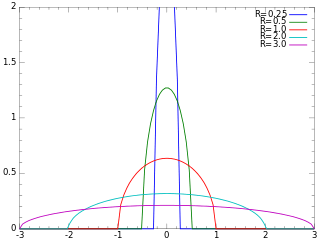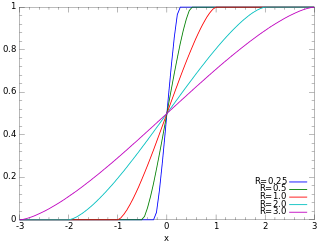Wigner semicircle distribution
|
Probability density function
| |
|
Cumulative distribution function
| |
| Parameters | radius (real) |
|---|---|
| Support | |
| CDF |
for |
| Mean | |
| Median | |
| Mode | |
| Variance | |
| Skewness | |
| Ex. kurtosis | |
| Entropy | |
| MGF | |
| CF | |
The Wigner semicircle distribution, named after the physicist Eugene Wigner, is the probability distribution supported on the interval [−R, R] the graph of whose probability density function f is a semicircle of radius R centered at (0, 0) and then suitably normalized (so that it is really a semi-ellipse):
for −R ≤ x ≤ R, and f(x) = 0 if R < |x|.
This distribution arises as the limiting distribution of eigenvalues of many random symmetric matrices as the size of the matrix approaches infinity.
It is a scaled beta distribution, more precisely, if Y is beta distributed with parameters α = β = 3/2, then X = 2RY – R has the above Wigner semicircle distribution.
General properties
The Chebyshev polynomials of the second kind are orthogonal polynomials with respect to the Wigner semicircle distribution.
For positive integers n, the 2n-th moment of this distribution is
where X is any random variable with this distribution and Cn is the nth Catalan number
so that the moments are the Catalan numbers if R = 2. (Because of symmetry, all of the odd-order moments are zero.)
Making the substitution into the defining equation for the moment generating function it can be seen that:
which can be solved (see Abramowitz and Stegun §9.6.18) to yield:
where is the modified Bessel function. Similarly, the characteristic function is given by:
where is the Bessel function. (See Abramowitz and Stegun §9.1.20), noting that the corresponding integral involving is zero.)
In the limit of approaching zero, the Wigner semicircle distribution becomes a Dirac delta function.
Relation to free probability
In free probability theory, the role of Wigner's semicircle distribution is analogous to that of the normal distribution in classical probability theory. Namely, in free probability theory, the role of cumulants is occupied by "free cumulants", whose relation to ordinary cumulants is simply that the role of the set of all partitions of a finite set in the theory of ordinary cumulants is replaced by the set of all noncrossing partitions of a finite set. Just as the cumulants of degree more than 2 of a probability distribution are all zero if and only if the distribution is normal, so also, the free cumulants of degree more than 2 of a probability distribution are all zero if and only if the distribution is Wigner's semicircle distribution.
See also
- The W.s.d. is the limit of the Kesten–McKay distributions, as the parameter d tends to infinity.
- In number-theoretic literature, the Wigner distribution is sometimes called the Sato–Tate distribution. See Sato–Tate conjecture.
- Marchenko–Pastur distribution or Free Poisson distribution
References
- Milton Abramowitz and Irene A. Stegun, eds. Handbook of Mathematical Functions with Formulas, Graphs, and Mathematical Tables. New York: Dover, 1972.
External links
- Eric W. Weisstein et al., Wigner's semicircle

